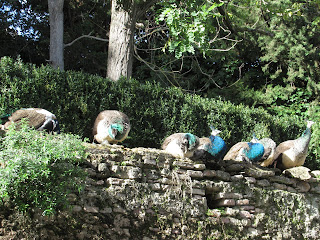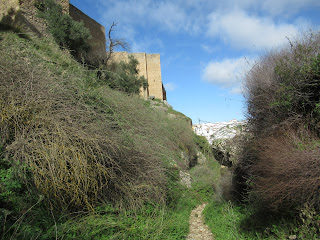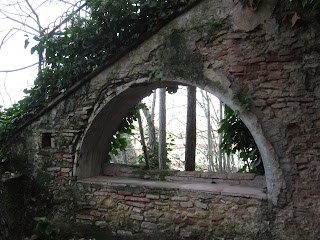After seeing Ronda's gorgeous ravine from its 'New Bridge' the last couple of days, we wanted to try and explore it from a much closer perspective if we could. Walking through the old town, we noticed the first marker in the Via Crucis, also known as the Way of the Cross and the Stations of the Cross.

Do you think a little sign indicating "Dangerous Path: Real Risk of Death" was going to dissuade us from going further on the trail? Not hardly!
Our first afternoon, we'd stood on the lookout by the gazebo in the top middle of this photo and looked down into the valley and across to where we now stood. It was neat seeing the lookout from this different perspective.
You can see what a long way we hiked down to get this shot of the New Bridge. I could hardly believe the blue skies we had as it'd been a long time since we'd seen them - what a welcome sight!
I wish we could remember all the places in the world where we've been lucky enough to see rock cairns or stacked rocks like these. I hadn't known until fairly recently that they represented for some a memorial, while for others it was an indication simply that people had visited there. You might want to google rock cairns and read about the controversy of people building them.
On our way back through town, we stopped at the Mondragon Palace that we'd first seen the day before. The palace had been built in the 14th century for the residence of the Moorish kings but they never lived there. The palace housed Ronda's Municipal Museum but it was pricey and not of great interest to us with its emphasis on prehistory and geology, so we gave it a miss after poking our heads in the courtyard.
Of more interest to us were the attractive wrought-iron balconies and windows on the buildings in the square surrounding the palace.
I don't know how we missed seeing the Stations yesterday when we'd walked right by here then!
Nancyanna: Do you remember these same charming cobblestone lanes and arches when you visited Ronda many years back? I wonder if you also made a point of seeing the town's amazing Bullring, the first one in all of Spain?
A few blocks away was the Plaza de Maria Auxiliadora which had two rare pinsapaos, trees that resembled extra large Christmas trees in the middle of the park. This part of Andalusia in Spain was the only region in Europe that these ancient trees still grew.
The pretty statue was a tribute to the Duchesa de Parcent whoever she was!
Through the trees we caught a glimpse of the beautiful Iglesia de Santa Maria we'd toured yesterday.
Another view of the historic City Hall that we'd also viewed from the church the previous day:
For an intense workout we decided to hike down the long hill to another viewpoint for a reputedly picture-perfect view of the bridge and ravine from the other side. On the way, we saw these ruins from the 11th century Moorish Alcazaba which was partially destroyed during the siege of Ronda in 1485 and later by French troops in the 1812 Peninsular War. Its location gave it strategic importance for the entire city.
We explored some of the old fortifications nearby.
They led us to the Church of the Holy Spirit which was created by the Catholic monarchs on top of a mosque in another part of the old town. The church comprised just one nave divided into three parts. It was finished in 1505, the year Queen Isabella died. Above the doorway was a small niche with a dove which symbolized the Holy Spirit.
On the altarpiece were three shields carved in stone. The painting above the altar was of the coming of the Holy Spirit. In the center was a wood painting of La Virgen de la Antigua in a beautiful Byzantine style.
The church's Stairway to Heaven, perhaps!
The ashlar stone Sacristy had small enclosures for the church's prized possessions.
Lovely stained-glass windows adorned the space above the choir.
This view will give you an idea why Ronda was named one of the loveliest of southern Spain's White Hill towns with its white-washed houses.
Instead of spending time in the town as we'd been doing for so long, it was a great change of scene walking along the narrow trail along the cliff under the fortified walls.
We'd hoped to see the Arab Baths but they were closed because of damage caused by one of the many storms the area had recently experienced. The baths were located half underground to maintain the temperature. Water was hoisted from the river below to the aqueduct by ceramic containers attached to a belt powered by a horse walking in circles.
A few steps away was the tiny Hermitage to Sts. Michael and Cruz.
From this spot, we had a better view of the Ara Baths below.
How refreshing seeing the farmland and not more churches for a bit!
The oldest bridge in Ronda was the Arab Bridge, sometimes mistakenly called the Roman Bridge although it was more likely built long after the Romans left. For centuries, this was the main gate to the fortified city. In Moorish times, people would purify both their bodies and souls from the water of the Rio Grande before entering the city.
This was the postcard view of the New Bridge we'd hiked to view!
When we heard the truck coming, we had to get off immediately so we wouldn't get squished on the narrow bridge!
We then had a long hike up steep steps toward another bridge and back to the old town.
The views were so spectacular and gave us the perfect reason to stop periodically on the climb.
The Philip V Gate was for centuries the main gate to the fortified city of Ronda.
The Palacio del Marques de Salvatierra, located just beyond the arch we'd just walked through, may have been a fun place to stop but it was also closed. I read in Rick Steves' book about Spain that this grand house was given by the Spanish king to the Salvatierra family as part of the 'distribution' of spoils following the Reconquista here in 1485. On the balcony above the door were statues of four Peruvian Indians symbolizing the colonial period from Spanish America. Just click on the photo to get a closer look.
Preening on the stone wall as we continued our climb were seven peacocks! We stood for several minutes with my hoping I could get all seven of the gorgeous creatures facing the same direction at the same time for 'the perfect shot.' Ha - it was like hoping to corral young children to act on cue.

How attractive it was coming across the bright colors and pretty pots of flowers set against the stark white buildings.
Suellen: Doesn't this fellow look like the Travelocity gnome from The Amazing Race, our favorite TV show? I hope we'll get to see more episodes from a new season soon as I need my fix!
At last, we found the 14th century Arab fortress called the Secret Mine. It was also known as the Palace of the Moorish King after President McKinley's grandson gave it the nickname after his relative uncle lived there! According to local legend, the Muslim King Abomelic built this military structure in the days when Ronda occupied a strategic position on the border between Castile and what would become the Nasrid Kingdom of Granada. In popular culture, the mine was rumored to house hidden palaces for queens and other legends.
I bet you also wouldn't want to miss exploring the mine or palace even if it meant walking down an exhausting series of 280 slick, dark and narrow stairs, now would you?! But Steves' description of its being like climbing down and then up a 20-story building made us catch our breath for a moment and wonder about what we'd committed to.
Periodically, there were small openings so we had plenty of fresh air and a tantalizing view of the world outside.
At the bottom of the steps was the Hall of the Spring where there'd once been a well where slaves used a noria, a machine activated by water power to bring up the water, and then formed a human chain to pass it in bags made of animal hide up to the town high above the water.
Further down was a military tower built from the river rocks which defended the mine and served as a secret escape hatch from the town. One room had space for weapons and cauldrons of boiling oil or water which could be poured from the central window to defend the outer gate. Above the tower was the Terrace of the Conquest where sentries kept watch over the gorge and provided the first line of defense.
Smelling the fresh air again and seeing the mighty river made the long hike down and the prospect of the one back up well worth it.
With its innovative engineering and architectural solutions for overcoming the 240 foot drop between the tower and the river, the mine was an extraordinarily well preserved and unique structure in Spain. Our hearts were certainly pumping much faster than normal once we finally reached the top of the mine!
Even though the palace was closed and its once wonderful belle epoque garden was overgrown, it was still delightful in our eyes.
The garden was a great spot for more panoramic views of Ronda.
If you read the first post I wrote a few days ago about Ronda, you'll perhaps remember seeing the gardens on the other side of the ravine. We were heading there next before finally reaching the town.
I could certainly see why Michelle Obama and her girls also chose to stop off here when they visited Spain several years ago. I wonder if they all trudged down the mine's gazillion steps to the river?
Our return to the downtown area brought us to the Old Bridge that was rebuilt in 1616 on the ruins of an Arab bridge. The New Bridge that we'd walked across several times was, by comparison, built from 1751 to 1793!
At the end of the other side of the bridge was the Iglesia de Padre Jesus. By then, we knew it had formerly been a mosque because the shape of the bell tower resembled a minaret. In front was the Fountain of 8 Jets.
We were happy to arrive at the Cuenca Gardens that were built in 1975 on the edge of the gorge for the twinning of Ronda and the city of Cuenca, located in southern Ecuador's Andes Mountains, as we'd spent several days in Cuenca just a year previously when touring much of South America.
The gardens were spread out over 23 horizontal terraces connected by many flights of stairs to overcome the nearly 80 foot difference in height between the top and bottom. In 2016, the gardens were transformed into a rose garden with 61 different varieties and 994 rose bushes! The first roses we saw and smelled were the La Sevillana variety.
In the background was the Palace of the Moorish King and its mine we'd just toured.
I wondered why these roses were named after the French crooner Charles Aznavour whom I hadn't thought of in at least 40 years. I just googled him and discovered he was of Armenian and Georgian heritage - two countries we visited at the beginning of this four plus month trip - and that he'd just died in October.
We must have stumbled on the French terrace as these roses were called The Gardens of France!
We couldn't believe our good luck seeing any roses, let alone all these, still blooming in late November.
I was excited when we could hear the same great minstrel on the terrace on the other side of the ravine we'd heard the afternoon before.
You really get a sense of the gardens' many terraces and all the many steps we had to climb to have this marvelous view. This day was like the 'day of a thousand steps' at least!
We'd started the day so many hours ago coming from the upper right and the new part of Ronda, then crossed the New Bridge to see the gorge from the opposite side and then circled our way all the way around the old town and the gorge to finally end up back to where we started. The long trek and its many steps had been so worth it for all the stupendous views we had along the way.
Next post: Relaxing in Ronda and on to Algeciras.
Posed on the eve of Valentine's Day, 2019, from our home in sunny Colorado.



















































































































I'm not sure my new bionic knee could make all the stairs in the Secret Mine. And it must have been slippery. Janina
ReplyDelete